

Rajgir. Rajgir (Hindi: राजगीर, Urdu: راجگیر) is a city and a notified area in Nalanda district in the Indian state of Bihar.
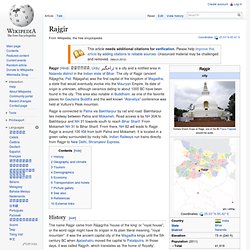
The city of Rajgir (ancient Rājagṛha; Pali: Rājagaha) was the first capital of the kingdom of Magadha, a state that would eventually evolve into the Mauryan Empire. Its date of origin is unknown, although ceramics dating to about 1000 BC have been found in the city. This area also notable in Buddhism, as one of the favorite places for Gautama Buddha and the well known "Atanatiya" conference was held at Vulture's Peak mountain. History[edit] Ancient Indian (Bharata) cities and Places (Title and location names are in English.) The name Rajgir came from Rājagṛiha 'house of the king' or "royal house", or the word rajgir might have its origian in its plain literal meaning, "royal mountain". Dasaratha Maurya. Dasaratha (252–224 BCE) was Mauryan Emperor from 232 to 224 BCE.

He was a grandson of Ashoka and had succeeded his father as the imperial ruler of India. Dasaratha presided over a declining imperium and several territories of the empire broke away from central rule during his reign. He had continued the religious and social policies of his celebrated grandfather Ashoka. Dasaratha was the last ruler of the Mauryan dynasty to have issued imperial inscriptions—thus the last Mauryan Emperor to be known from epigraphical sources. Dasaratha died in 224 BCE and was succeeded by his probable son or brother Samprati. Background[edit] Administration[edit] Mauryan Empire (Dark Blue) at its maximum extent under Ashoka, including its vassals (Light Blue). The political unity of the Mauryan Empire did not long survive Ashoka's death.[2] One of Dasaratha's uncles, Jalauka, set up an independent kingdom in Kashmir. Religion[edit] Culture[edit] Succession[edit] Notes[edit] Karnataka - Ashoka 's Swarnabhoomi. With the dawn of historic period, Karnataka which was conquered by Nandas was included in the empire of Ashoka.
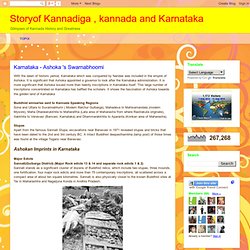
It is significant that Ashoka appointed a governor to look after the Karnataka administration. It is more significant that Ashoka issued more than twenty inscriptions in Karnataka itself. Asoka on ancient Indian sculptures. Maha_5.jpg (JPEG Image, 425x552 pixels) Maurya. Ajatasatru. The approximate extent of the Magadha state in the 5th century BCE Ajatasatru's stupa in Rajgir, where his ashes were interred Birth[edit] Ajatasatru is also known as Kunika.
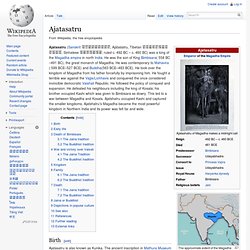
The ancient inscription in Mathura Museum refers to him as vaidehi putra Ajatasatru Kunika. The story of Ajatasatru is found in Buddhists Tripitakas and Jain Agamas. According to "Nirayavalika Sutta" of Jaina Aagams, during her pregnancy Queen Chelna had the strong desire to eat fried flesh of her husband's (King Bimbisara's) heart and drink liquor. Early life[edit] The Geographical Locations of The Rock Edicts of Asoka - Buddha's world. THE locations of the edicts are of geographical importance, as the selection of their sites was not arbitrary.
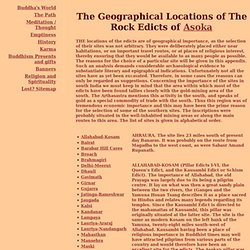
They were deliberately placed either near habitations, or on important travel routes, or at places of religious interest, thereby ensuring that they would be available to as many people as possible. The reasons for the choice of a particular site will be given in this appendix. Such an analysis demands considerable archaeological evidence to substantiate literary and epigraphical indications. Unfortunately not all the sites have as yet been excavated.
Therefore, in some cases the reasons can only be regarded as suggestions. AHRAURA. ALLAHABAD-KOSAM (Pillar Edicts I-VI, the Queen's Edict, and the Kausambi Edict or Schism Edict). BAIRAT(Minor Rock Edict and the Bbabra Edict). BARABAR HILL CAVES (Donatory inscriptions to the Ajivika sect). BRAHMAGIRI(Minor Rock Inscription). DELHI-MEERUT and DELHI-TOPRA (Pillar Edict, I-VI and I-VII respectively). DHAULI (Major Rock Edicts). KING ASHOKA: His Edicts and His Times. King Asoka, the third monarch of the Indian Mauryan dynasty, has come to be regarded as one of the most exemplary rulers in world history.
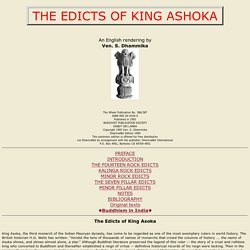
The British historian H.G. Wells has written: "Amidst the tens of thousands of names of monarchs that crowd the columns of history ... the name of Asoka shines, and shines almost alone, a star. " Although Buddhist literature preserved the legend of this ruler -- the story of a cruel and ruthless king who converted to Buddhism and thereafter established a reign of virtue -- definitive historical records of his reign were lacking. Then in the nineteenth century there came to light a large number of edicts, in India, Nepal, Pakistan and Afghanistan.
These edicts, inscribed on rocks and pillars, proclaim Asoka's reforms and policies and promulgate his advice to his subjects. //Dhamma sadhu, kiyam cu dhamme ti? But in 1837, James Prinsep succeeded in deciphering an ancient inscription on a large stone pillar in Delhi. All men are my children. Virtual Art Exhibit - The Mauryan Empire.
The Edicts of King Asoka. The Edicts of King Asoka An English rendering by Ven.

S. Dhammika The Wheel Publication No. 386/387 ISBN 955-24-0104-6 Copyright © 1993 Ven. Mauryan Empire Maps. The Mauryan Empire lasted from c.321 - 185 B.C.
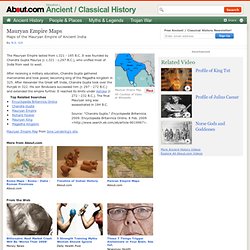
It was founded by Chandra Gupta Maurya (r. c.321 - c.297 B.C.), who unified most of India from east to west. After receiving a military education, Chandra Gupta gathered mercenaries and took power, becoming king of the Magadha kingdom in 325. After Alexander the Great left India, Chandra Gupta took over the Punjab in 322. His son Bindusara succeeded him (r. 297 - 272 B.C.) and extended the empire further. It reached its limits under Ashoka (r. 272 - 232 B.C.).
Source: "Chandra Gupta. "